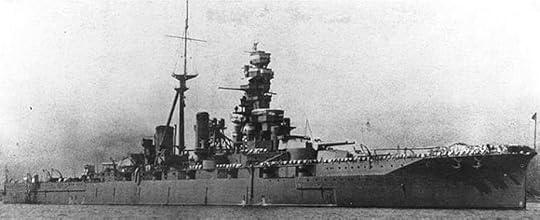The theory of the top-heavy novel
During World War II, several classes of Japanese Battleships were employed in the South Pacific. They were deemed top-heavy, because their superstructures towered above their main decks, and they looked as though they were going to topple at any minute. Kind of like a Kayne West song: you think it’s going to fall apart any second.
The same thing can happen in a novel. Bad Moon Rising was about 70k, For None of Woman Born was around 72-73k, and A Once Distant Memory will eventually be fleshed out to about 75k.

Battleship Hiei, 1943
Molon Labe will be around 150k, bigger than my first two novels combined. At around 75k, the story began to wobble. Characters were acting in a static manner. The plot seemed to be going nowhere, and while I was in an area that bridged two scenes together, there was little doubt the story would go down in the same manner Indiana Jones did in Temple of Doom.
It can be discouraging when it seems like your novel, which had direction before, is now falling apart. One of my friends, Stacy Buck, wrote a post about using an outline to complete a novel, especially in Scrivener. While I am not going back to the beginning of the novel, I did start utilizing an outline to start detailing the upcoming events. Some of the outlines I wrote worked well; others needed tweaking.
The moral of the story is, when you story seems to be getting overwhelming and on the verge of collapse, either tweak the outline or start using one to get you through the difficult points in the story.



